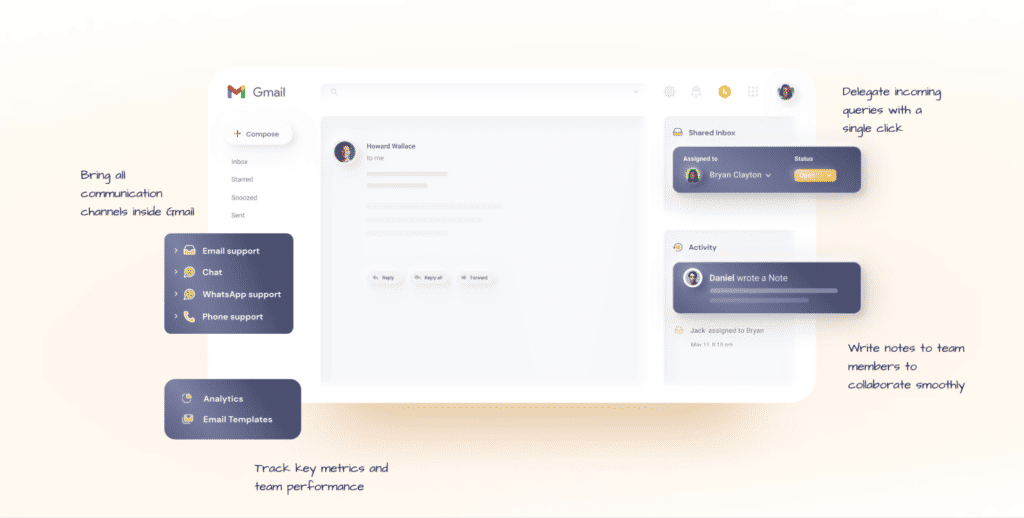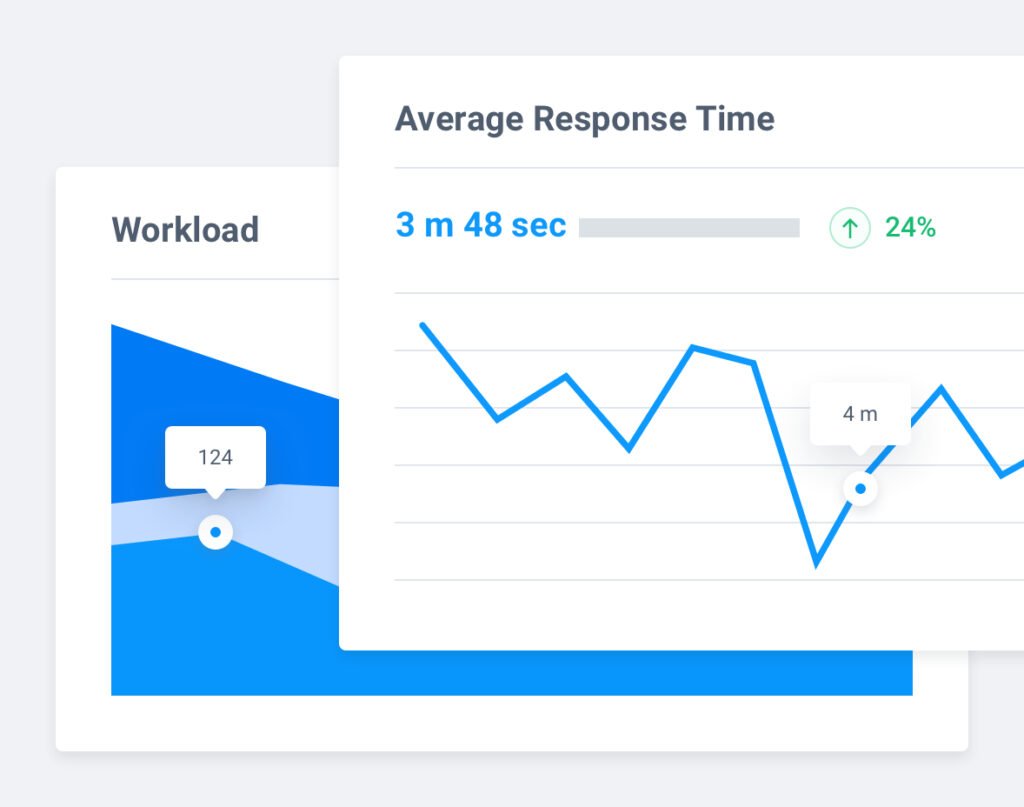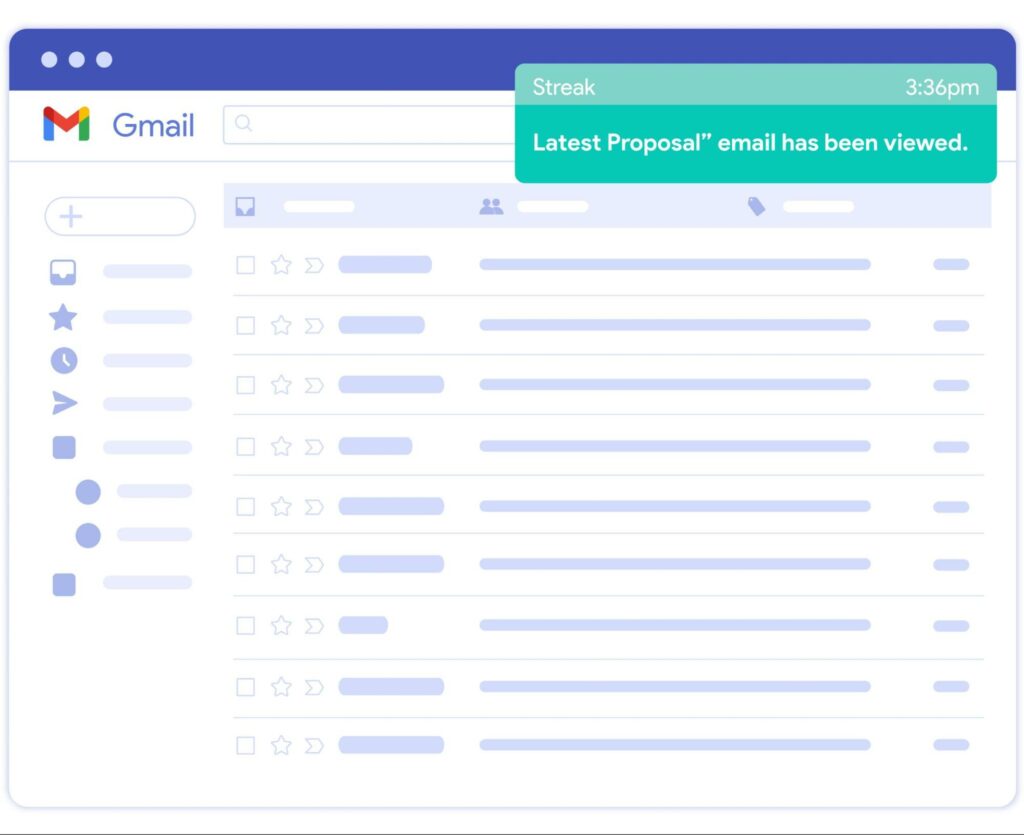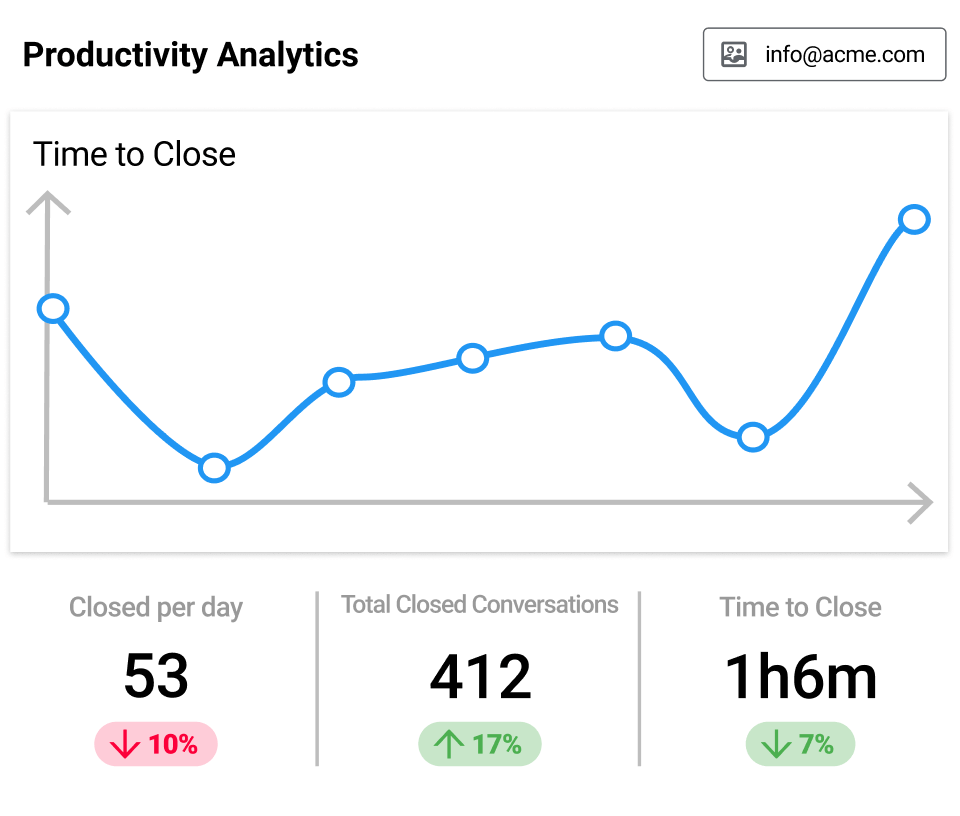5 Best Gmail Response Time Tracking Tools
Table of contents
Do you know how long it takes you to respond to emails? If not, you’re not alone. Many people don’t track their email response time, but it’s an important metric to measure.
After all, your email response time can have a big impact on your customer satisfaction, sales, and team productivity.
Whether it’s a customer inquiry or a vendor question, the clock starts ticking the moment that email hits your inbox. Quick responses not only meet customer expectations but also set the set the tone for the relationship going forward. Plus, let’s not forget about team efficiency. The faster you clear that inbox, the more you can focus on what really matters.
Table of Contents
- What is Gmail Response Time Tracking?
- 5 Benefits of Using a Gmail Response Time Tracking Tool
- Top 5 Recommended Gmail Response Time Tracking Tools
- Frequently Asked Questions (FAQs)
- How to choose a Gmail response time tracking tool?
What is Gmail Response Time Tracking?
As the name suggests, Gmail response time tracking is the process of monitoring the time it takes you or your team to respond to incoming messages. You can do this manually by tracking the time difference between the receipt of the email and your response to it.
But a much more efficient way to approach this would be automating the process by using a Gmail response time tracking tool. It doesn’t make sense to deploy crucial man hours for this.
As an added benefit, the tool will also provide you with detailed insights about your response time. Here’s how this can help different teams in your organization –
- Your support team can track response times to make sure they’re responding to customer inquiries and complaints promptly. This’ll significantly improve customer satisfaction.
- Similarly, your sales team can use the response time tracking tool to prioritize any leads they may have and make sure they’re following up with them and responding to them quickly. It could be the difference between closing a customer vs losing one to a competitor.
- You can even use this internally within your company to get better visibility into your team’s performance. Management teams can use this to figure out how prompt their teams are and how available they are. This information can be used to identify areas for improvement and make changes to team workflows.
Overall, Gmail response time tracking is a pretty valuable tool that can help you improve your efficiency and effectiveness across functions.
5 Benefits of Using a Gmail Response Time Tracking Tool
Here are some of the benefits of using a Gmail response time tracking tool in more detail:
- Automatic tracking: Gmail response time tracking tools automatically track the time it takes you to respond to each email. This saves you time and effort and ensures that you have accurate data on your email response times.
- Detailed reports: Gmail response time tracking tools can generate a variety of reports, such as:
- Average response time: This metric shows you how long it takes you to respond to emails on average.
- Response time by sender: This metric shows you how long it takes you to respond to emails from different senders. This information can be helpful for identifying important clients or customers who need to be prioritized.
- Response time by day of the week: This metric shows you how long it takes you to respond to emails on different days of the week. This information can be helpful for identifying trends in your email workflow.
- Response time by time of day: This metric shows you how long it takes you to respond to emails at different times of the day. This information can be helpful for identifying time slots when you’re most productive or when you need to take breaks.
- Emails that have not been responded to: This report shows you a list of all of the emails that you have not yet responded to. This can help you to stay on top of your inbox and avoid forgetting to respond to important emails.
- Team tracking: Gmail response time tracking tools can also track the email response times of your team members. This can be helpful for managers who want to ensure that their team is responding to emails in a timely manner. You can use this information to identify team members who need additional support or to identify areas where your team’s email workflow can be improved.
- Benchmarks: Some Gmail response time tracking tools also provide benchmarks for different industries and job titles. This can help you compare your email response times to those of your peers and identify areas where you can improve.
- Identify areas for improvement: Tracking your email response time can help you to identify areas where you need to improve. For example, if you notice that you are taking longer to respond to emails on certain days of the week, you can try to set aside more time for email on those days. Or, if you notice that you are taking longer to respond to emails from certain senders, you can prioritize those emails or delegate them to someone else.
When you know that you are tracking your email response time, it is more likely that you will make a conscious effort to respond to emails promptly. This is because you will know that your performance is being measured, and you will want to make sure that you are meeting your own expectations.
Overall, Gmail response time tracking tools can be a valuable asset for businesses of all sizes. They can help you to improve customer satisfaction, sales, and team productivity.
Top 5 Recommended Gmail Response Time Tracking Tools
Navigating the array of Gmail response time tracking tools can be a tad overwhelming, hence picking the one that aligns with your needs is crucial.
In this section, we’ll recommend a few of the best Gmail response time tracking tools on the market.
| Tool | Key Features | Pricing |
|---|---|---|
| Hiver | Gmail-based help desk software; SLA management; detailed email response time reports; granular metrics like first, next, and periodic response. | Free: Free forever Lite: $19/user/month Pro: $49/user/month Elite: $79/user/month |
| EmailMeter | Response time trends; broad email analytics; visual analytics; data accessibility up to 2 years. | Free versionTeams: $15/user/month |
| Mixmax | Real-time email tracking; basic and advanced tracking; email tracking and analytics; reporting and analytics. | SMB: $34/user/monthGrowth: $65/user/monthGrowth + Salesforce: $69/user/monthEnterprise: Custom pricing |
| Streak | Free email view tracking; basic CRM functionalities; link tracking. | Free planSolo: $15-$19/user/monthPro: $49-$59/user/monthPro+: $69-$89/user/monthEnterprise: $129-$159/user/month |
| Gmelius | Email tracking; robust analytics; automation features; team collaboration within Gmail. | Plus: $15/user/monthGrowth: $29/user/monthPro: $69/user/month |
1. Hiver
Hiver is the world’s first omnichannel Gmail-based help desk software that lets you offer email, chat support, voice support, and WhatsApp messaging support to your customers. Since it’s built inside Gmail, it’s incredibly user-friendly with a negligible learning curve.

Its most prominent time-tracking feature is helping you manage customer expectations with its SLA management capabilities.
You can easily set up your business hours and then create SLA policies depending on the customer type or severity of the issues. This way, someone from the team can step in and nip the problem in the bud before it snowballs.
You can also set up SLA reports and view detailed SLA compliance and violation reports for each email conversation.
Moreover, Hiver’s detailed reports on email response time can be a valuable tool for businesses and individuals who want to provide timely support and assistance. By understanding your email response time metrics, you can identify areas where you can improve and make changes to your email workflow.
Setting up reports on Hiver only takes a fraction of the time in comparison to other tools.
Also, Hiver allows you to analyze your response times at every email level. This means not only can you check your average response time, but you can also dig deeper and analyze this metric by:
1. First response: Time taken to acknowledge your customer’s query
2. Next response: Time taken to respond to your customer’s subsequent reply
3. Periodic response: Time taken to send up a follow-up email to your response in case the customer hasn’t replied
Apart from these granular metrics, Hiver also offers the following analytics to help you track Gmail response times.
- Conversation Reports: These reports help you understand the effectiveness of your team’s customer interactions. They provide metrics on the number of conversations, response times, and resolution times. This data can be invaluable for identifying bottlenecks and areas for improvement.
Use these reports to gauge how well your team is managing customer conversations and to identify areas where training or process changes may be needed.
- User Reports: These focus on individual agent performance, providing data on average response and resolution times, as well as Customer Satisfaction (CSAT) ratings. This granular data can help you identify top-performing agents and those who may need additional training or support.
- Tag Reports: These reports allow you to categorize and track email conversations based on tags like ‘high priority’ or ‘urgent’.
Use Tag Reports to spot trends or recurring issues in customer conversations, enabling you to address them before they escalate proactively.
6 Essential Customer Service Reports That You Need to Track
- Number of Customer Requests Received: Helps in staffing and task assignment by showing daily customer request volumes.
- Requests Closed Per Agent: Measures individual agent efficiency and helps in workload distribution.
- Average Response Time: Indicates how quickly agents are responding to customer queries.
- Average Handle Time: Measures the time agents take to resolve customer issues.
- First Contact Resolution: Focuses on resolving customer issues in the first interaction. Pro-tip: Use a comprehensive knowledge base and streamlined workflows to improve first contact resolution rates.
- Customer Satisfaction (CSAT): Measures overall customer satisfaction post-interaction. Pro-tip: Collaborate with product and marketing teams to act on customer feedback.
These additional reports by Hiver offer a more comprehensive view of your customer service operations, helping you to fine-tune your strategies for better performance and customer satisfaction.
Pricing:
Hiver offers a free plan with powerful help desk functionalities that works right within your inbox. Paid plans starts at $19/user/month, billed annually.
Here’s how Kiwi achieved a 100% SLA success rate with Hiver
2. EmailMeter
EmailMeter presents itself as an adept tool for businesses aiming to track email response times on Gmail. Here’s a breakdown of its features and pricing with respect to email time tracking:

Features:
Response Time Tracking:
- Response Time Trends: EmailMeter allows tracking of email response times on a week-by-week basis, which can be instrumental in observing whether there’s an improvement or deterioration over time.
- Custom Metrics: Create and save metrics with specific filters and conditions, a feature that can be leveraged to monitor response times among other metrics closely.
General Email Analytics:
EmailMeter provides a broad spectrum of email statistics including tracking and measuring email volumes, individual productivity, and Service Level Agreements (SLAs) alongside response times.
Visual Analytics:
Visual progress tracking over time is facilitated with daily, weekly, and monthly breakdowns, which could be crucial for a business in evaluating its email response efficiency.
Data Accessibility:
With EmailMeter, you can access up to 2 years of past data which can be exported in CSV format. This feature might come in handy for historical analysis and reporting.
Pricing:
EmailMeter offers a free version for basic email analytics. Its paid plans start at $15 per month and unlock advanced features like extended data access.
3. Mixmax
Mixmax is a Gmail response time tracking tool that offers a variety of features to help users improve their email workflow, including email tracking, email scheduling, and email templates. Mixmax also tracks the time it takes users to respond to emails and provides users with detailed reports on their email response time.

MixMax is a multifaceted tool that goes beyond just email tracking, offering a suite of features to enhance email productivity, analytics, and engagement. Here are the aspects of MixMax that pertain to email time tracking along with its pricing:
Features:
Real-Time Email Tracking:
MixMax provides real-time tracking of email opens, clicks, and overall engagement, which can be crucial for understanding recipient interaction and response times.
Basic and Advanced Tracking:
With basic tracking, you can see if, when, and how many times your email was opened. An upcoming feature, Advanced Tracking, will provide insights into the geographic location of where your email was opened and on what device it was viewed. For group emails, you’ll see exactly who opened it.
Email Tracking and Analytics:
The tool helps analyze which emails work best for sales and marketing campaigns by providing powerful insights about recipient engagement through its tracking tools.
Reporting & Analytics:
Available in certain pricing tiers, this feature helps provide a detailed analysis of response time and engagement rates, aiding in informed decision making.
Pricing:
Mixmax has a free plan for teams under five people, with features like instant scheduling, email tracking, and email templates. Its paid plans start at $29 per user per month and offer more functionality. You can also get a custom enterprise plan if you’re a larger team that requires enterprise controls & custom setup.
Note: Mixmax has a unique pricing model in the sense that its cost varies depending on the number of messages sent and the number of words written in the emails. For instance, they charge $1 per 1,000 messages sent for free users, and $10 for 10,000 messages. The per-word charge is $0.02 for free users and $0.05 for paid users.
4. Streak
Streak is tailored towards integrating a CRM (Customer Relationship Management) system within Gmail, but it also boasts features that can be leveraged for email time tracking.

Here’s how Streak can be utilized as a time-tracking tool alongside its pricing:
Features:
Email Tracking:
Streak provides free email view tracking that allows you to see if your recipients opened your email, how many times they opened it, and when each view happened.
You can also send mass emails to only those recipients who viewed your last email, thereby improving your response rate and saving time.
The email tracking feature is part of the free plan which you can start using by just downloading the free Chrome extension, making it easy to begin collecting data without any additional effort.
Analytics:
Although detailed analytics regarding response times aren’t explicitly mentioned, the email view tracking feature could provide a base layer of analytics to measure how quickly recipients are viewing your emails.
Pricing:
Streak has a forever free plan for individuals with basic CRM functionalities along with email tracking. Its paid plans start at $49 per user per month and are suited for businesses of any size, looking for a complete CRM.
Streak’s free email view tracking feature can be a starting point for businesses looking to monitor email responsiveness within Gmail. The pricing structure allows for scaling up to more comprehensive CRM functionalities as needed, albeit the details regarding advanced email time tracking analytics are not explicitly outlined.
5. Gmelius
Gmelius is a collaboration platform integrated within Gmail, offering an array of features to streamline email management and team collaboration.

Here’s a glimpse of its features and pricing concerning email time tracking:
Features:
Email Tracking:
While the exact specifics of email time tracking aren’t delineated, Gmelius does provide powerful analytics for teams, which could be utilized to monitor email response times and enhance overall email management strategies.
Analytics:
Gmelius offers robust analytics that might be utilized to scrutinize email response times and overall email engagement, aiding in optimizing daily operations.
Automation:
The platform also houses features like sequences, email scheduling, email templates, auto follow-ups, and CRM integration, all of which can be instrumental in managing email response times more effectively.
Collaboration:
By converting email inboxes into a workspace for team collaboration, Gmelius facilitates managing projects and client interactions directly within the Gmail platform, which can indirectly contribute to better email time management.
Pricing:
Gmelius offers a 7-day free trial for its premium plans, which could be a good opportunity to explore its email time tracking features. It’s paid plans start at $12 per user per month.
Gmelius vs. DragApp vs. Hiver: What to Choose in 2024 (Comparison)
Gmelius’ blend of analytics, automation, and collaboration within Gmail makes it a potent tool for businesses keen on enhancing their email response time tracking and overall email management operations.
Frequently Asked Questions (FAQs)
Here are some frequently asked questions about Gmail response time tracking tools.
1. Why is tracking response time in Gmail important?
Tracking the response times can help you in various ways. It can help keep your support team accountable and ensure they respond to customers in a timely fashion. Similarly, it can help your sales team make sure they respond to prospects or inquiries promptly.
2. How do these tools work?
These tools integrate with Gmail and track the time stamps of sent and received emails. They calculate the time duration between receiving an email and sending a reply.
3. Are these tools difficult to install?
Most of these tools are extremely user-friendly and easy to install. They often come as browser extensions or add-ons that can be integrated with a few clicks. Although some may require additional configuration based on the user’s specific needs.
4. Is it possible to track the response time of individual team members using these tools?
Yes, several Gmail response time tracking tools allow you to track individual team members’ response times. This feature is useful for managers and team leaders to monitor performance across the team.
5. Are these tools compliant with privacy regulations?
Most reputable tools are designed to be compliant with major privacy regulations like GDPR. However, it’s important to review the privacy policy of the specific tool to ensure compliance, especially when dealing with sensitive information.
6. Do these tools work with all email types in Gmail?
Yes, generally these tools work with most email types in Gmail. However, there might be limitations with certain types of encrypted or specially formatted emails. It’s best to check with the specific tool’s documentation for any limitations.
How to choose a Gmail response time tracking tool?
When choosing a Gmail response time tracking tool, it’s important to consider the following factors:
- Features: What features are important to you? Do you need a tool that can track your response time by sender, day of the week, or time of day? Do you need a tool that can generate reports?
- Ease of use: How easy is the tool to use? Can you easily set up your account and start tracking your response time?
- Price: How much does the tool cost? Are there any free or limited free plans available?
Once you’ve considered these factors, you can start to narrow down your choices.

































